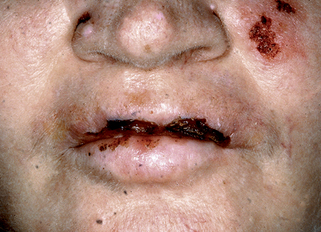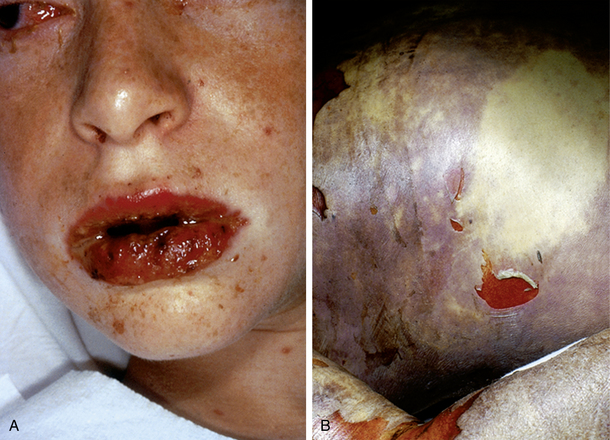Chapter 64 Dermatologic emergencies
1. “Dermatologic emergencies” sounds like an oxymoron. Are there dermatologic emergencies?
Yes. Several groups of diseases in dermatology are emergencies. In some, the skin is the primary organ affected (e.g., pemphigus vulgaris) and, in others, the cutaneous manifestations are an important diagnostic finding of a severe underlying condition (e.g., meningococcemia). Rapid recognition and diagnosis of dermatologic emergencies are important because these conditions are often acutely lethal but can be treated successfully if the diagnosis is made early in the disease course.
2. What are the major groups of dermatologic emergencies?
• Vesiculobullous disorders and drug reactions (e.g., Stevens-Johnson syndrome, toxic epidermal necrolysis, pemphigus vulgaris)
• Autoimmune disorders (e.g., acute cutaneous eruption of systemic lupus erythematosus, juvenile rheumatoid arthritis)
• Inflammatory cutaneous disorders (e.g., desquamative erythroderma, acute pustular psoriasis, acute drug eruptions)
Vesiculobullous disorders and drug reactions
3. How does toxic epidermal necrolysis differ from the Stevens-Johnson syndrome or erythema multiforme major?
Toxic epidermal necrolysis (TEN) and Stevens-Johnson syndrome are commonly confused entities, in part because many clinicians use the two terms interchangeably. Because these two diseases have significantly different prognoses and treatments, it is important to differentiate between them (Table 64-1). The diseases can usually be distinguished by their clinical presentation (Fig. 64-1), histologic findings, and course.
Table 64-1. Clinicopathologic Features of Toxic Epidermal Necrolysis (TEN) versus Stevens-Johnson Syndrome (SJS)
| TEN | SJS | |
|---|---|---|
| Maximal intensity | 1–3 days | 7–15 days |
| Skin pain | Severe | Minimal |
| Mucosal involvement | Mild | Severe |
| Lesional pattern | Diffuse erythema, desquamation | Annular and targetoid lesions |
| Skin histology | Few inflammatory cells | Numerous inflammatory cells |
| Prognosis | Poor | Excellent |
4. How do you treat TEN?
Patients with TEN should be treated as burn patients, with supportive care to maintain fluid balance, avoid infection, and prevent adult respiratory distress syndrome (ARDS). In essence, TEN patients should be treated as severe burn victims. There are in vitro data to suggest that this entity may be the result of direct toxicity of drugs, or their metabolites, to skin cells. Anecdotal reports suggest that systemic corticosteroids are actually detrimental to TEN patients, although others continue to advocate their use. Initial anecdotal reports suggested that intravenous immunoglobulin therapy improved survival; however, this is controversial because other reports have not demonstrated efficacy.
5. How do you treat Stevens-Johnson syndrome?
Stevens-Johnson syndrome appears to be immunologically mediated and responds to systemic corticosteroids. Patients with severe symptoms, especially involvement of the oral mucosa, which interferes with eating and fluid intake, may be treated with a short trial of systemic corticosteroids. Stevens-Johnson syndrome is usually a self-limited disease with a 3-week course, and milder cases may not require systemic corticosteroids. Some authorities consider the use of systemic corticosteroids in this condition as controversial, because there are no good prospective, controlled studies evaluating this treatment. Therefore, an empirical 3- to 4-day trial of high-dose systemic steroids should be considered. If there is no clinical improvement at that time, the treatment should be discontinued.
6. What is pemphigus vulgaris?
Pemphigus vulgaris is a superficial blistering disease that typically affects middle-aged individuals (Fig. 64-2). It often presents initially with mouth ulcerations (60% of cases) but can involve blistering on areas above the waist. Pemphigus vulgaris may present acutely and, in severe cases, may resemble TEN or Stevens-Johnson syndrome. Early diagnosis is important because this condition is usually fatal if untreated, and current therapies are effective.


Figure 64-2. Pemphigus vulgaris demonstrating erosive lesions of the lips and left cheek.
(Courtesy of James E. Fitzpatrick, MD.)
Groves RW: Pemphigus: a brief review, Clin Med 9: 371–375, 2009.
7. Describe Nikolsky’s sign and its relationship to pemphigus vulgaris.
Pemphigus vulgaris involves only the upper layers of the epidermis; therefore, the blisters are very fragile, and typically patients present with only superficial ulcerations. Because of the fragility of the skin, one can apply lateral pressure with a finger to the intact skin around a lesion, causing the upper layer of the skin to become detached. This is called the Nikolsky’s sign, and it occurs in pemphigus and other superficial blistering diseases. This clinical sign can be helpful in differentiating superficial from deeper blistering diseases (e.g., bullous pemphigoid, bullous lupus erythematosus), in which Nikolsky’s sign is usually absent.
8. How is pemphigus vulgaris treated?
Therapy is designed to decrease the production of the antidesmosomal antibodies or to reduce the inflammatory response. Because pemphigus can be deadly, corticosteroids in high doses are used initially, despite their serious side effects. Prednisone is given in daily oral doses of 120 mg as an initial dose, which is then adjusted lower or higher depending on the patient response. Other immunosuppressive drugs, such as azathioprine and cyclophosphamide, have been used in conjunction with corticosteroids because of their steroid-sparing effect.
9. What is the DRESS syndrome?
DRESS stands for drug rash with eosinophilia and systemic symptoms, and it is a life-threatening reaction. It is characterized by a papulosquamous eruption, fever, enlarged lymph nodes, leukocytosis with eosinophilia, and liver or kidney involvement. Typical drugs that induce this reaction include anticonvulsants, allopurinol, and other sulfa drugs. The syndrome develops several weeks after drug initiation and can persist and recur for prolonged periods after the drug has been stopped. Therapy includes high-dose steroids and cyclophosphamide.
10. Are any dermatologic emergencies infectious in origin?
Yes. These are most commonly bacterial (e.g., necrotizing fasciitis, tularemia, meningococcemia, subacute and acute bacterial endocarditis) but also include viral infections (e.g., hemorrhagic fevers, neonatal herpes simplex infection), rickettsial infections (e.g., Rocky Mountain spotted fever), and fungal infections (e.g., mucormycosis).
11. Can emergent infections be differentiated by their cutaneous presentations?
Yes, although few cutaneous findings in emergent infections are pathognomonic. Infections that involve the skin can be organized generally by the appearance of the primary lesion (Table 64-2). Major cutaneous patterns of presentation include
• Petechial/purpuric papules (e.g., chronic gonococcal septicemia, meningococcemia, subacute/acute bacterial endocarditis, and Rocky Mountain spotted fever) (Fig. 64-3)
12. What is the differential to consider in hemorrhagic lesions other than infection?
• Coagulation abnormalities, such as idiopathic thrombocytopenia, disseminated intravascular coagulation, and clotting factor deficiencies
• Vasculitides, such as leukocytoclastic vasculitis secondary to an underlying collagen vascular disease, or periarteritis nodosa
13. What causes necrotizing fasciitis?
Necrotizing fasciitis has been well described for years but has recently received much attention in the lay press as the “flesh-eating bacteria.” It is a bacterial infection that is rapidly progressive, often over hours, destroying muscle and subcutaneous tissues. Death or loss of a limb may occur, if it is not diagnosed and treated early in its course. It is most commonly associated with β-hemolytic streptococci but may also be due to other gram-positive or gram-negative organisms, or it may be polymicrobial.
Table 64-2. Diagnostic Signs in Dermatologic Infectious Emergencies
| Petechial/Palpable Purpura |
| Violaceous Skin Discoloration |
Stay updated, free articles. Join our Telegram channel
Full access? Get Clinical Tree
 Get Clinical Tree app for offline access
Get Clinical Tree app for offline access

|






